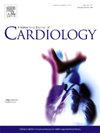Prevention of readmission by intensified follow-up after transcatheter aortic valve implantation: Feasibility results of the PREMISS randomised controlled trial
IF 3.2
2区 医学
Q2 CARDIAC & CARDIOVASCULAR SYSTEMS
引用次数: 0
Abstract
Background
Hospital readmissions after transcatheter aortic valve implantation (TAVI) are common. This study aimed to investigate the feasibility and impact of an intensified follow-up intervention on cardiac readmissions, mortality, and self-reported health status post-TAVI.
Methods
The study was designed as a randomised controlled trial to compare an early follow-up intervention with standard care. The intervention included tailored telephone and in-hospital consultations within 30 days post-TAVI. The feasibility outcomes were enrolment, attrition, and completion rates. Efficacy outcomes included all-cause mortality, cardiac-related hospital readmissions, and self-reported health status at 30 and 90 days after TAVI.
Results
Eighty patients were randomised to either the intensified or standard follow-up. The intervention was feasible, achieving a 73 % recruitment rate (target >50 %), 0 % attrition, 93 % questionnaire completion, and 100 % follow-up during the 30-day intervention and 90-day follow-up period. Detailed insights into processes, resources, management, and scientific approach of the intervention were provided. There was no mortality within 90 days in both groups. Cardiac readmissions within 90 days were 11 (28 %) in the standard care group vs 4 (10 %) in the intervention group (p = 0.04); this difference was mostly driven by short (<24-h) cardiac readmissions in the early post-TAVI period (13 % vs 0 %, respectively). Early improvements in self-reported health status occurred in both groups with no significant differences between groups.
Conclusion
An intensified follow-up intervention combining telephone and outpatient consultations after discharge from TAVI was shown to be feasible with high recruitment and completion rates. This study indicates that an intensified follow-up post-TAVI may prevent early cardiac readmissions.
经导管主动脉瓣置入术后加强随访预防再入院:PREMISS随机对照试验的可行性结果。
背景:经导管主动脉瓣植入术(TAVI)后再入院是常见的。本研究旨在探讨强化随访干预对tavi后心脏再入院、死亡率和自我报告健康状况的可行性和影响。方法:本研究设计为随机对照试验,比较早期随访干预与标准治疗。干预措施包括在tavi后30 天内进行量身定制的电话和住院咨询。可行性结果包括入学率、损耗率和完成率。疗效结果包括TAVI后30天和90 天的全因死亡率、心脏相关医院再入院率和自我报告的健康状况。结果:80例患者随机分为强化随访组和标准随访组。干预是可行的,在30天的干预和90天的随访期间,招募率为73% %(目标bbb50 %),损失率为0% %,问卷完成率为93% %,随访率为100% %。提供了对干预过程、资源、管理和科学方法的详细见解。两组在90 天内均无死亡。标准治疗组90 天内心脏再入院11例(28 %),干预组4例(10 %)(p = 0.04);结论:TAVI出院后加强电话和门诊会诊的随访干预是可行的,招募率和完成率都很高。本研究表明,tavi后加强随访可预防早期心脏再入院。
本文章由计算机程序翻译,如有差异,请以英文原文为准。
求助全文
约1分钟内获得全文
求助全文
来源期刊

International journal of cardiology
医学-心血管系统
CiteScore
6.80
自引率
5.70%
发文量
758
审稿时长
44 days
期刊介绍:
The International Journal of Cardiology is devoted to cardiology in the broadest sense. Both basic research and clinical papers can be submitted. The journal serves the interest of both practicing clinicians and researchers.
In addition to original papers, we are launching a range of new manuscript types, including Consensus and Position Papers, Systematic Reviews, Meta-analyses, and Short communications. Case reports are no longer acceptable. Controversial techniques, issues on health policy and social medicine are discussed and serve as useful tools for encouraging debate.
 求助内容:
求助内容: 应助结果提醒方式:
应助结果提醒方式:


